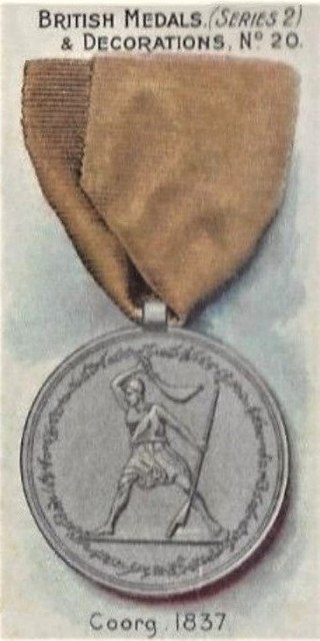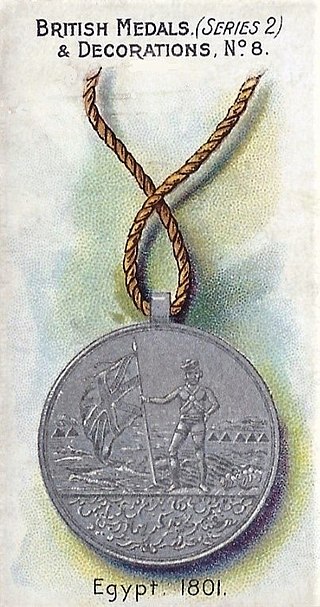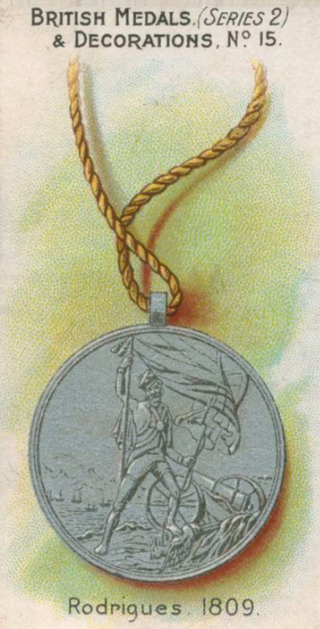
The India General Service Medal was a campaign medal approved on 1 March 1854, for issue to officers and men of the British and Indian armies. It was awarded for various minor military campaigns in India and nearby countries, between 1852 and 1895.

The Indian General Service Medal was a campaign medal approved on 1 January 1909, for issue to officers and men of the British and Indian armies. From 1919, it was also awarded to officers and men of the Royal Air Force, with the Waziristan 1925 clasp awarded solely to the RAF.

The Indian General Service Medal was a campaign medal approved on 3 August 1938, for issue to officers and men of the British and Indian armies, and of the Royal Air Force.

The Army of India Medal (AIM) was a campaign medal approved in 1851 for issue to officers and men of the British Army and the Army of the Honourable East India Company. A retrospective award following the precedent set by the Naval General Service Medal and the Military General Service Medal, it served to reward service in various actions from 1803 to 1826.

The China War Medal 1900 was a British campaign medal approved on 1 January 1902 for issue to British and Indian land and sea troops who served during the Boxer Rebellion, between 10 June and 31 December 1900. The medal was issued in silver to combatants and in bronze to native, namely Indian, bearers drivers and servants.

The India Medal was a campaign medal approved in 1896 for issue to officers and men of the British and Indian armies.

The Tibet Medal was authorised in February 1905 for all members of the Tibet Mission and accompanying troops who served at or beyond Siliguri from 13 December 1903, to 23 September 1904.

The 61st Pioneers were an infantry regiment of the British Indian Army. They trace their origins to 1758, when they were raised as the 1st Battalion Coast Sepoys.

The Seringapatam Medal, or Sri Ranga Pattanam Medal, is a campaign medal that was awarded by the Governor-General of India to all British and Indian soldiers who participated in the British victory in the Battle of Seringapatam in 1799.

The Abyssinian War Medal was awarded for service between 4 October 1867 and 19 April 1868 to those who participated in the 1868 Expedition to Abyssinia. This punitive expedition, led by Lieutenant-General Sir Robert Napier, was carried out by the armed forces of the British Empire against the Ethiopian Empire. Emperor Tewodros II of Ethiopia imprisoned several missionaries and two representatives of the British government. The punitive expedition launched by the British in response required transporting a sizable military force hundreds of miles across mountainous terrain lacking any road system.

The Jellalabad Medal was a campaign medal issued by the British East India Company. It was established by Lord Ellenborough, the Governor-General of India, on 30 April 1842.
The medal was awarded for the defence of Jalalabad from 12 November 1841 to 7 April 1842, during the First Afghan War, to the troops under the command of Sir Robert Sale. About 2,600 soldiers took part, including the 13th Foot, the 35th Bengal Native Infantry, as well as detachments from other Indian Army units and some loyal Afghan forces.

The Kelat-I-Ghilzie Medal is a campaign medal issued by the British East India Company, to the defenders of the fort at Kelat-I-Ghilzie during the First Anglo-Afghan War.

The Capture of Ceylon Medal is a campaign medal that was awarded by the Governor-General of India to soldiers in Bengal artillery units of the armies of the East India Company (EIC) who took part in the capture of Ceylon in 1795–96.

The Java Medal is a campaign medal awarded by the Governor-General of India to soldiers of the armies of the Honourable East India Company (HEIC) who participated in the Invasion of Java in August and September 1811, during the Napoleonic Wars.

The Nepal Medal was awarded by the Honourable East India Company (HEIC) to native Indian officers, and Indian soldiers for particularly distinguished conduct, during the Anglo-Nepalese War of 1814–16.

The Burma Medal is a campaign medal awarded by the Governor-General of India to native Indian soldiers of the armies of the Honourable East India Company (HEIC) who participated in the First Burma War from April 1824 to February 1826.

The Coorg Medal was awarded by the Honourable East India Company (HEIC) to local forces who remained loyal during the Coorg rebellion of 1837.

The Deccan Medal was the first campaign medal instituted by the East India Company (EIC). It was awarded to native Indian troops who took part in the major campaigns in India between 1778 and 1784. It is sometimes referred to as the Carnatic Medal.

The Egypt Medal is a campaign medal that was awarded by the Governor-General of India to members of the expeditionary force that travelled from India to take part in the 1801 Egyptian campaign, a part of the French Revolutionary Wars.

The Medal for the capture of Rodrigues, Isle of Bourbon and Isle of France is a campaign medal that was awarded by the Governor-General of India to native Indian soldiers of the East India Company (EIC), who took part in the capture of these three Indian Ocean islands from French forces between July 1809 and December 1810.




















